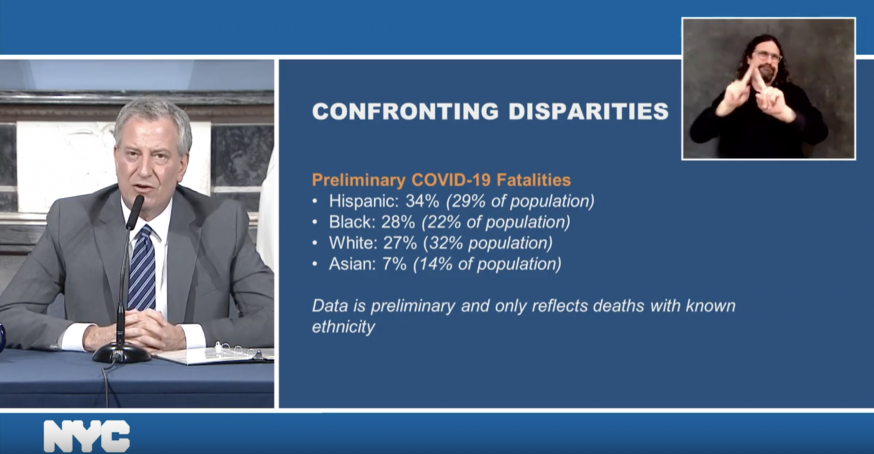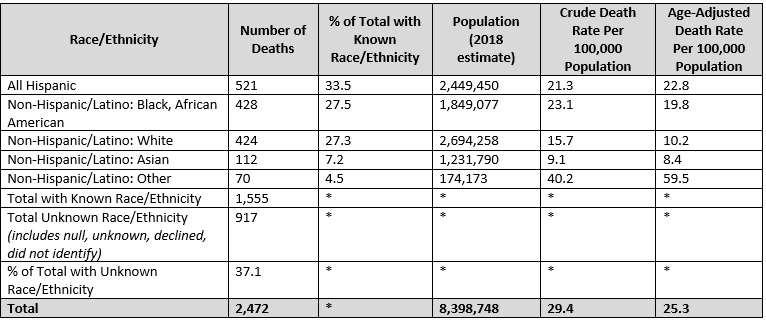
City Hall press conference April 8
April 8, 2020 By Allie Griffin
The coronavirus is disproportionately killing Hispanic and Black New Yorkers across the five boroughs, according to newly released data.
Hispanic and Latino people account for 34 percent of all COVID-19 related deaths in New York City, while they make up about 29 percent of the city’s population, according to preliminary data.
The City’s Black residents make up about 28 percent of COVID deaths citywide, but are just 22 percent of the city’s population. In comparison, White New Yorkers make up 32 percent of the city population, but make up 27 percent of coronavirus deaths.
“There are clear inequalities, clear disparities in how this disease is affecting the people of our city,” Mayor Bill de Blasio said at his daily coronavirus briefing this morning.
The demographic data supports earlier geographic data of coronavirus cases that showed neighborhoods where low-income communities of color live have had higher numbers of cases.
The larger Corona area in Queens has been called the epicenter of the epicenter of the coronavirus pandemic in New York. The neighborhood is 75 percent Hispanic and more than 20 percent of its population lives below the poverty line.
It has the highest number of COVID-19 cases in the city, with 1,659 confirmed as of yesterday evening.
The now documented disparities should “cause great concern,” de Blasio said.
The disparities in coronavirus deaths correlates with healthcare disparities faced by low income and minority communities, who may not have access to or be able to afford quality healthcare, he said.
“The truth is that in so many ways the negative effects of coronavirus — the pain it’s causing, the death it’s causing — tracks with other profound healthcare disparities that we have seen for years and decades in this city,” he said solemnly.
“We’re seeing folks who have struggled before really being hit particularly hard by the coronavirus,” he added. “That’s a blatant inequality.”
The City’s Health Commissioner, Dr. Oxiris Barbot said immigration status and fears around it could also be playing a role in how the virus is disproportionately killing Latinos.
“I am very concerned when I see the large percentage of Latinos who have died of this illness,” she said.
While the city’s public hospitals treat all New Yorkers regardless of their immigration or insurance status, the fear prevails among Hispanic New Yorkers, Barbot said.
“The overlay of the anti-immigrant rhetoric across this country I think has real implications in the health of our community.”
Dr. Barbot also said the communities which have been harder hit by the virus have higher premature mortality rates during normal times due to higher rates of underlying chronic illnesses and the coronavirus is compounding this.
The Mayor is launching a campaign to address the disparities, beginning with a “double down” effort to ensure that the city’s public hospitals are fully equipped with what they need to treat patients with coronavirus.
“We need to ensure that our public hospitals get absolutely everything they need because we know that so many new yorkers who are in the most vulnerable communities, in the most danger — where do they turn to?” de Blasio asked. “They turn to our public hospitals, the most obvious example is Elmhurst Hospital in Queens. We’ve all seen what’s played out there.”
Elmhurst Hospital has become ground zero of the pandemic in New York City and lines of people waiting to get tested for COVID-19 has continuously wrapped around amid near constant sirens.
“The public hospitals are the greatest guarantee we have that there will be fairness in saving lives,” the mayor said.
The Mayor is also launching a multi-million dollar public awareness campaign in 14 different languages focused on specific zip codes with the highest number of coronavirus cases.
He said the inequalities in healthcare must be addressed.
“We’re all trying to fight this battle and keep focused and keep calm in the midst of a battle that we must win,” de Blasio said. “And as leaders we have to stay calm, but it made me angry to see that the disparities that have plagued this city — this nation — that are all about fundamental inequality are once again causing such pain and causing innocent people to lose their lives.”

Source: DOH
